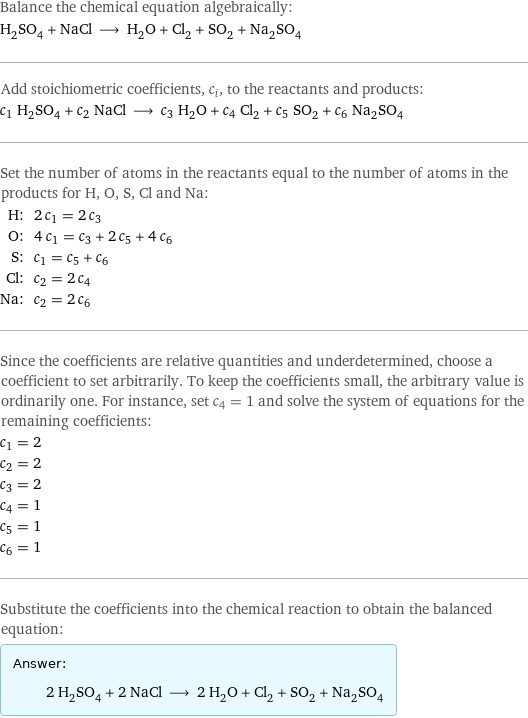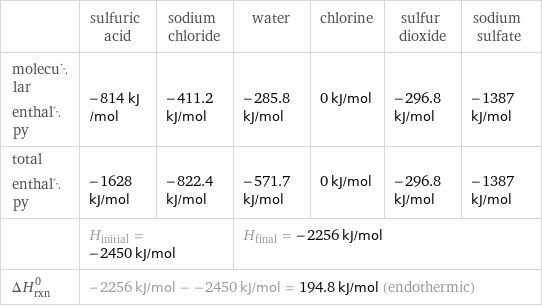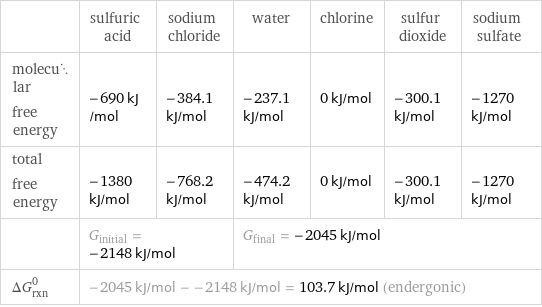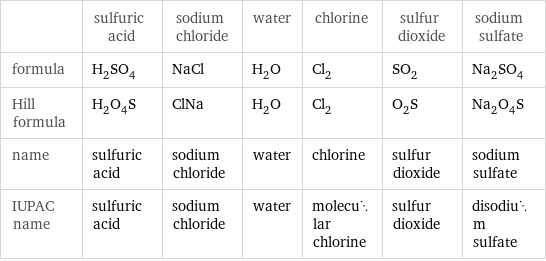Input interpretation

H_2SO_4 sulfuric acid + NaCl sodium chloride ⟶ H_2O water + Cl_2 chlorine + SO_2 sulfur dioxide + Na_2SO_4 sodium sulfate
Balanced equation

Balance the chemical equation algebraically: H_2SO_4 + NaCl ⟶ H_2O + Cl_2 + SO_2 + Na_2SO_4 Add stoichiometric coefficients, c_i, to the reactants and products: c_1 H_2SO_4 + c_2 NaCl ⟶ c_3 H_2O + c_4 Cl_2 + c_5 SO_2 + c_6 Na_2SO_4 Set the number of atoms in the reactants equal to the number of atoms in the products for H, O, S, Cl and Na: H: | 2 c_1 = 2 c_3 O: | 4 c_1 = c_3 + 2 c_5 + 4 c_6 S: | c_1 = c_5 + c_6 Cl: | c_2 = 2 c_4 Na: | c_2 = 2 c_6 Since the coefficients are relative quantities and underdetermined, choose a coefficient to set arbitrarily. To keep the coefficients small, the arbitrary value is ordinarily one. For instance, set c_4 = 1 and solve the system of equations for the remaining coefficients: c_1 = 2 c_2 = 2 c_3 = 2 c_4 = 1 c_5 = 1 c_6 = 1 Substitute the coefficients into the chemical reaction to obtain the balanced equation: Answer: | | 2 H_2SO_4 + 2 NaCl ⟶ 2 H_2O + Cl_2 + SO_2 + Na_2SO_4
Structures

+ ⟶ + + +
Names

sulfuric acid + sodium chloride ⟶ water + chlorine + sulfur dioxide + sodium sulfate
Reaction thermodynamics
Enthalpy

| sulfuric acid | sodium chloride | water | chlorine | sulfur dioxide | sodium sulfate molecular enthalpy | -814 kJ/mol | -411.2 kJ/mol | -285.8 kJ/mol | 0 kJ/mol | -296.8 kJ/mol | -1387 kJ/mol total enthalpy | -1628 kJ/mol | -822.4 kJ/mol | -571.7 kJ/mol | 0 kJ/mol | -296.8 kJ/mol | -1387 kJ/mol | H_initial = -2450 kJ/mol | | H_final = -2256 kJ/mol | | | ΔH_rxn^0 | -2256 kJ/mol - -2450 kJ/mol = 194.8 kJ/mol (endothermic) | | | | |
Gibbs free energy

| sulfuric acid | sodium chloride | water | chlorine | sulfur dioxide | sodium sulfate molecular free energy | -690 kJ/mol | -384.1 kJ/mol | -237.1 kJ/mol | 0 kJ/mol | -300.1 kJ/mol | -1270 kJ/mol total free energy | -1380 kJ/mol | -768.2 kJ/mol | -474.2 kJ/mol | 0 kJ/mol | -300.1 kJ/mol | -1270 kJ/mol | G_initial = -2148 kJ/mol | | G_final = -2045 kJ/mol | | | ΔG_rxn^0 | -2045 kJ/mol - -2148 kJ/mol = 103.7 kJ/mol (endergonic) | | | | |
Equilibrium constant
![Construct the equilibrium constant, K, expression for: H_2SO_4 + NaCl ⟶ H_2O + Cl_2 + SO_2 + Na_2SO_4 Plan: • Balance the chemical equation. • Determine the stoichiometric numbers. • Assemble the activity expression for each chemical species. • Use the activity expressions to build the equilibrium constant expression. Write the balanced chemical equation: 2 H_2SO_4 + 2 NaCl ⟶ 2 H_2O + Cl_2 + SO_2 + Na_2SO_4 Assign stoichiometric numbers, ν_i, using the stoichiometric coefficients, c_i, from the balanced chemical equation in the following manner: ν_i = -c_i for reactants and ν_i = c_i for products: chemical species | c_i | ν_i H_2SO_4 | 2 | -2 NaCl | 2 | -2 H_2O | 2 | 2 Cl_2 | 1 | 1 SO_2 | 1 | 1 Na_2SO_4 | 1 | 1 Assemble the activity expressions accounting for the state of matter and ν_i: chemical species | c_i | ν_i | activity expression H_2SO_4 | 2 | -2 | ([H2SO4])^(-2) NaCl | 2 | -2 | ([NaCl])^(-2) H_2O | 2 | 2 | ([H2O])^2 Cl_2 | 1 | 1 | [Cl2] SO_2 | 1 | 1 | [SO2] Na_2SO_4 | 1 | 1 | [Na2SO4] The equilibrium constant symbol in the concentration basis is: K_c Mulitply the activity expressions to arrive at the K_c expression: Answer: | | K_c = ([H2SO4])^(-2) ([NaCl])^(-2) ([H2O])^2 [Cl2] [SO2] [Na2SO4] = (([H2O])^2 [Cl2] [SO2] [Na2SO4])/(([H2SO4])^2 ([NaCl])^2)](../image_source/ee1f3e397624be371ef54e12e98c38ef.png)
Construct the equilibrium constant, K, expression for: H_2SO_4 + NaCl ⟶ H_2O + Cl_2 + SO_2 + Na_2SO_4 Plan: • Balance the chemical equation. • Determine the stoichiometric numbers. • Assemble the activity expression for each chemical species. • Use the activity expressions to build the equilibrium constant expression. Write the balanced chemical equation: 2 H_2SO_4 + 2 NaCl ⟶ 2 H_2O + Cl_2 + SO_2 + Na_2SO_4 Assign stoichiometric numbers, ν_i, using the stoichiometric coefficients, c_i, from the balanced chemical equation in the following manner: ν_i = -c_i for reactants and ν_i = c_i for products: chemical species | c_i | ν_i H_2SO_4 | 2 | -2 NaCl | 2 | -2 H_2O | 2 | 2 Cl_2 | 1 | 1 SO_2 | 1 | 1 Na_2SO_4 | 1 | 1 Assemble the activity expressions accounting for the state of matter and ν_i: chemical species | c_i | ν_i | activity expression H_2SO_4 | 2 | -2 | ([H2SO4])^(-2) NaCl | 2 | -2 | ([NaCl])^(-2) H_2O | 2 | 2 | ([H2O])^2 Cl_2 | 1 | 1 | [Cl2] SO_2 | 1 | 1 | [SO2] Na_2SO_4 | 1 | 1 | [Na2SO4] The equilibrium constant symbol in the concentration basis is: K_c Mulitply the activity expressions to arrive at the K_c expression: Answer: | | K_c = ([H2SO4])^(-2) ([NaCl])^(-2) ([H2O])^2 [Cl2] [SO2] [Na2SO4] = (([H2O])^2 [Cl2] [SO2] [Na2SO4])/(([H2SO4])^2 ([NaCl])^2)
Rate of reaction
![Construct the rate of reaction expression for: H_2SO_4 + NaCl ⟶ H_2O + Cl_2 + SO_2 + Na_2SO_4 Plan: • Balance the chemical equation. • Determine the stoichiometric numbers. • Assemble the rate term for each chemical species. • Write the rate of reaction expression. Write the balanced chemical equation: 2 H_2SO_4 + 2 NaCl ⟶ 2 H_2O + Cl_2 + SO_2 + Na_2SO_4 Assign stoichiometric numbers, ν_i, using the stoichiometric coefficients, c_i, from the balanced chemical equation in the following manner: ν_i = -c_i for reactants and ν_i = c_i for products: chemical species | c_i | ν_i H_2SO_4 | 2 | -2 NaCl | 2 | -2 H_2O | 2 | 2 Cl_2 | 1 | 1 SO_2 | 1 | 1 Na_2SO_4 | 1 | 1 The rate term for each chemical species, B_i, is 1/ν_i(Δ[B_i])/(Δt) where [B_i] is the amount concentration and t is time: chemical species | c_i | ν_i | rate term H_2SO_4 | 2 | -2 | -1/2 (Δ[H2SO4])/(Δt) NaCl | 2 | -2 | -1/2 (Δ[NaCl])/(Δt) H_2O | 2 | 2 | 1/2 (Δ[H2O])/(Δt) Cl_2 | 1 | 1 | (Δ[Cl2])/(Δt) SO_2 | 1 | 1 | (Δ[SO2])/(Δt) Na_2SO_4 | 1 | 1 | (Δ[Na2SO4])/(Δt) (for infinitesimal rate of change, replace Δ with d) Set the rate terms equal to each other to arrive at the rate expression: Answer: | | rate = -1/2 (Δ[H2SO4])/(Δt) = -1/2 (Δ[NaCl])/(Δt) = 1/2 (Δ[H2O])/(Δt) = (Δ[Cl2])/(Δt) = (Δ[SO2])/(Δt) = (Δ[Na2SO4])/(Δt) (assuming constant volume and no accumulation of intermediates or side products)](../image_source/1da6af994679edbba90342b84ebbf97e.png)
Construct the rate of reaction expression for: H_2SO_4 + NaCl ⟶ H_2O + Cl_2 + SO_2 + Na_2SO_4 Plan: • Balance the chemical equation. • Determine the stoichiometric numbers. • Assemble the rate term for each chemical species. • Write the rate of reaction expression. Write the balanced chemical equation: 2 H_2SO_4 + 2 NaCl ⟶ 2 H_2O + Cl_2 + SO_2 + Na_2SO_4 Assign stoichiometric numbers, ν_i, using the stoichiometric coefficients, c_i, from the balanced chemical equation in the following manner: ν_i = -c_i for reactants and ν_i = c_i for products: chemical species | c_i | ν_i H_2SO_4 | 2 | -2 NaCl | 2 | -2 H_2O | 2 | 2 Cl_2 | 1 | 1 SO_2 | 1 | 1 Na_2SO_4 | 1 | 1 The rate term for each chemical species, B_i, is 1/ν_i(Δ[B_i])/(Δt) where [B_i] is the amount concentration and t is time: chemical species | c_i | ν_i | rate term H_2SO_4 | 2 | -2 | -1/2 (Δ[H2SO4])/(Δt) NaCl | 2 | -2 | -1/2 (Δ[NaCl])/(Δt) H_2O | 2 | 2 | 1/2 (Δ[H2O])/(Δt) Cl_2 | 1 | 1 | (Δ[Cl2])/(Δt) SO_2 | 1 | 1 | (Δ[SO2])/(Δt) Na_2SO_4 | 1 | 1 | (Δ[Na2SO4])/(Δt) (for infinitesimal rate of change, replace Δ with d) Set the rate terms equal to each other to arrive at the rate expression: Answer: | | rate = -1/2 (Δ[H2SO4])/(Δt) = -1/2 (Δ[NaCl])/(Δt) = 1/2 (Δ[H2O])/(Δt) = (Δ[Cl2])/(Δt) = (Δ[SO2])/(Δt) = (Δ[Na2SO4])/(Δt) (assuming constant volume and no accumulation of intermediates or side products)
Chemical names and formulas

| sulfuric acid | sodium chloride | water | chlorine | sulfur dioxide | sodium sulfate formula | H_2SO_4 | NaCl | H_2O | Cl_2 | SO_2 | Na_2SO_4 Hill formula | H_2O_4S | ClNa | H_2O | Cl_2 | O_2S | Na_2O_4S name | sulfuric acid | sodium chloride | water | chlorine | sulfur dioxide | sodium sulfate IUPAC name | sulfuric acid | sodium chloride | water | molecular chlorine | sulfur dioxide | disodium sulfate